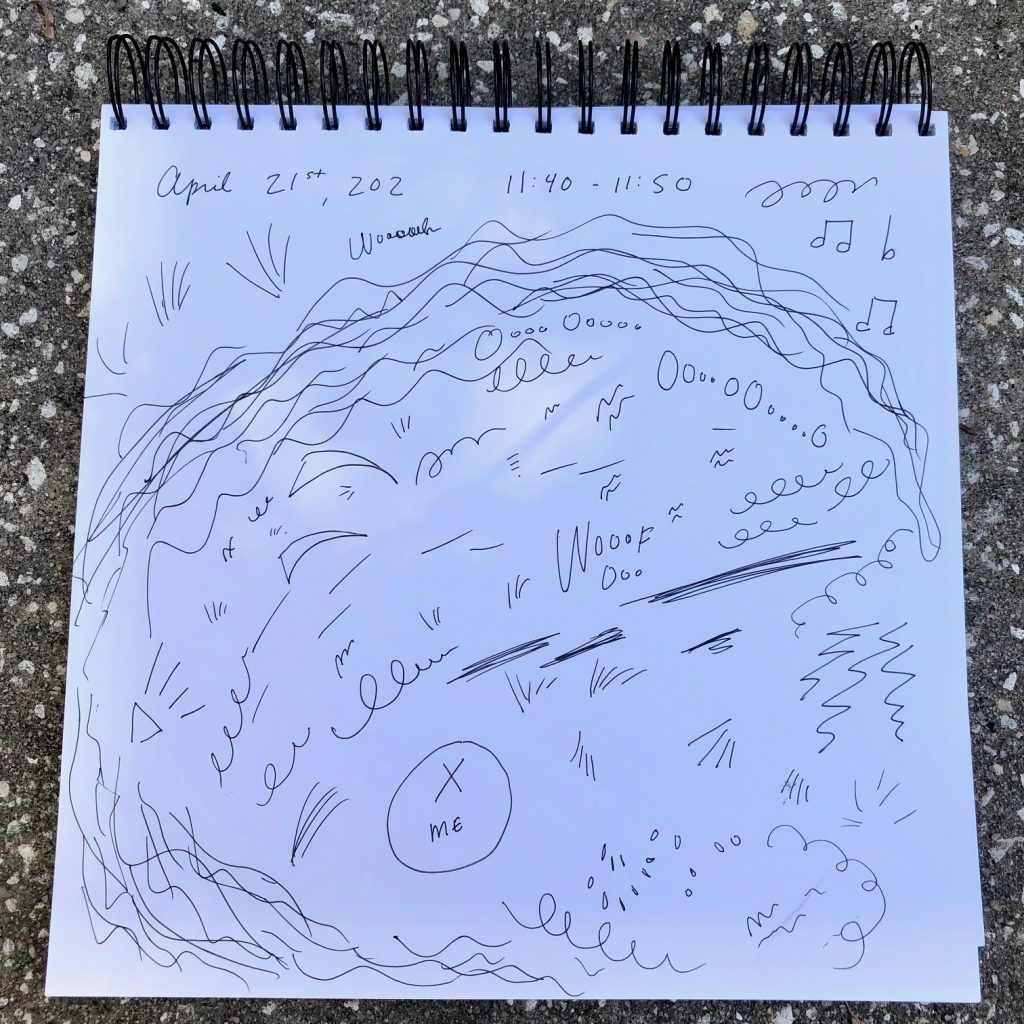When you do something noble and beautiful and nobody noticed, do not be sad. For the sun every morning is a beautiful spectacle and yet most of the audience still sleeps.
— John Lennon
In honor of Earth Week (you know, the week of Earth Day) and the beginnings of this blog, I’m celebrating each day with an activity that challenges me to get outside, think creatively, stretch my senses, and practice writing.
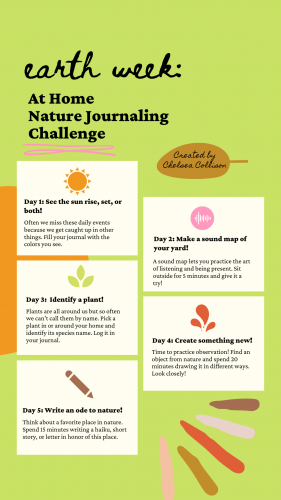
So often in museum education, we get caught up in the logistics and planning and forget to take moments to appreciate the Earth that we so strongly defend and represent. I plan to use this time to learn more about the beauty around me while also learning about myself. Let’s wonder & grow!
Each day features simple instructions for an activity that I’ll be completing starting with April 20th, 2020 but you can do it whenever you like! At the end of the day, I’ll blog about what the experience was like for me. You can record your activities in a physical journal, scrap paper, or notebook. I hope you follow along my little adventure while also doing the activities for yourself!
Day 1: See the sun rise, set, or both!
Often, we miss these daily events because we get caught up in other things. Fill your journal with the colors you see.
On the first day of Earth Week I challenge you to chase the sun! Sounds easy enough, right? Whenever I’m in a tropical place, catching sight of the sunrise or sunset quickly becomes part of the daily routine. But, when home, I frequently get caught up in keeping myself fed, washing the dishes, or sadly, staring at my phone and miss the big event, unless I just happen to take out the trash at the right time. For this day, I will not let that happen! After watching the sun rise and set, I’ll color in the first page of my journal with the colors of the sky.
April 20, 2020:
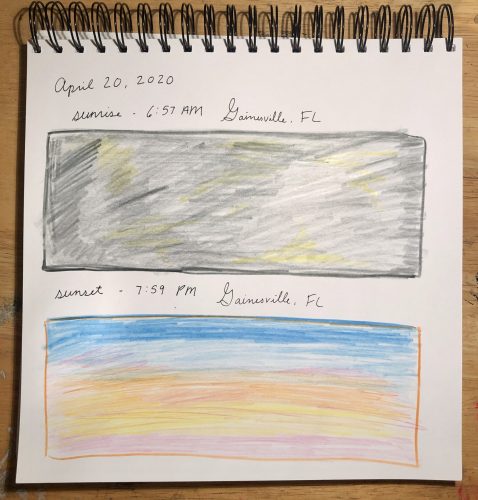
Oh, Mother Nature, always so unpredictable! I woke up this morning to try and catch the sunrise but was greeted with a thunderstorm instead. The funny thing was, if I had closed my eyes, I wouldn’t have known the difference if it weren’t for the thunder. The neighborhood birds (including the local rooster) were as talkative as ever! I sat on my porch and watched as the clouds moved quickly overhead and the lightning brightened the sky, instead of the expected sun.
For sunset, I drove south to the edge of Payne’s Prairie where the oak hammocks surrounding my neighborhood wouldn’t block the view. The skies were clear, and the colors were glorious! The weather from dawn to dusk changed completely. What a wonderful way to end the day.
Day 2: Make a sound map of your yard!
A sound map lets you practice the art of listening and being present. Sit outside for 5 minutes and give it a try!
I’ve never made a sound map so I’m very excited for this day! A sound map is a visual (sometimes digital) representation of the sounds in a specific location, in this case, our yards, fire escapes, or windows will work great!
To make the map, draw an X on the center of your paper. The X represents where you are sitting. When you hear a sound, make a mark on the paper to represent the sound. The location of the mark should indicate the direction and distance of the sound from your seat. You don’t need to draw a detailed picture for each sound, just make a simple mark. For example, a few wavy lines could represent a gust of wind, or a musical note could indicate a singing bird. Making simple marks keeps the focus on listening rather than on drawing. Spend 5-10 minutes recording the sounds in your area and add this to your journal.
April 21, 2020:
Wow, sound maps are so fun! I decided to make three, not because I’m an overachiever (maybe I am…) but because I became genuinely curious about how the sounds from my driveway and porch would differ throughout the day. If you look at the maps, you’ll see a ring around all of them, this is because my house is on a corner and there are always cars driving around it but the sound of cars was much more present around lunchtime than at 9 am or 6 pm. The sounds in the morning seemed to be everywhere even right next to me where in the evening everything sounded kind of far away. I really enjoyed this exercise and hope you did too!
Day 3: Identify a plant!
Plants are all around us but so often we can’t call them by name. Pick a plant in or around your home and identify its species name. Log it in your journal.
I don’t know about you, but I’m always impressed with people that can quickly identify plants! Working in a natural history museum means I’m always outnumbered by people that can identify a species of whatever it is I’ve found but, on this day, I want to be the expert! To accomplish this challenge, I plan to wander into my yard, find at least one plant I can’t name (this should take seconds), take a photo, and then use a field guide or the iNaturalist app to identify it! In my journal, I’ll quickly sketch the plant including details like leaf shape and once I know what it’s called, I’ll label it!
April 22, 2020:
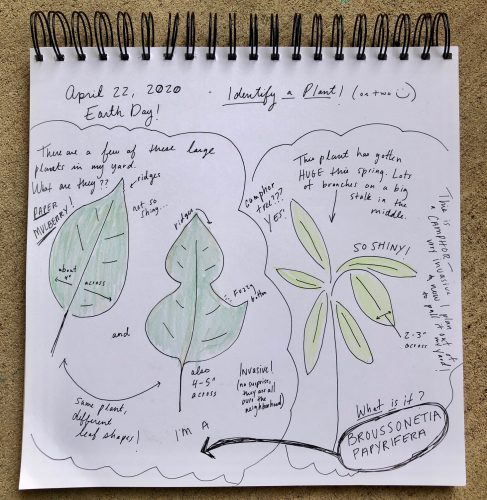
This was fun and harder than expected! I decided to identify two plants that I’ve been wondering about but hadn’t taken time to solve the mystery. No surprise, both plants are invasive! I took photos of the plants and uploaded them to iNaturalist. This got a quick identification for the paper mulberry but I was still unsure about the camphor tree because mine is quite a bit smaller than photos I saw of them online so, in the end, I did ask some expert friends who confirmed my suspicions. I now have plans this weekend to get that camphor out of my yard as it is growing too close to my magnolia for comfort. I hope you learned some things about your yard, too!
Day 4: Create something new!
Time to practice observation! Find an object from nature and spend 20 minutes drawing it in different ways. Look closely!
I checked out John Muir Laws’ book “The Laws Guide to Nature Drawing and Journaling” from the library before hunkering down at home and WOW, what a great book to have stuck with me. Today’s short challenge is inspired by this 300-page book full of inspiration.
First, focus on an object in the natural world that stands out in the moment. If you’re new to drawing, I recommend choosing something that is stationary, as movement adds a whole new level of the challenge. Spend a few minutes observing this object, move around to see it at different angles, feel the texture of the object, really focus your awareness on this one thing. When you feel like you’re ready, give yourself 2-5 minutes to try your hand at a blind contour drawing. This means doing a quick sketch of the outline of the object without looking at your paper! Blind contour drawing forces you to look at the object that you are drawing and helps to understand that representational drawing is all about observation.
When you’re finished with the blind contour, give yourself 15 minutes to draw the object to the best of your ability. Don’t worry too much about if it looks exactly like the object, just draw what you see, not what you think is there! Add this drawing to your nature journal.
April 23, 2020:
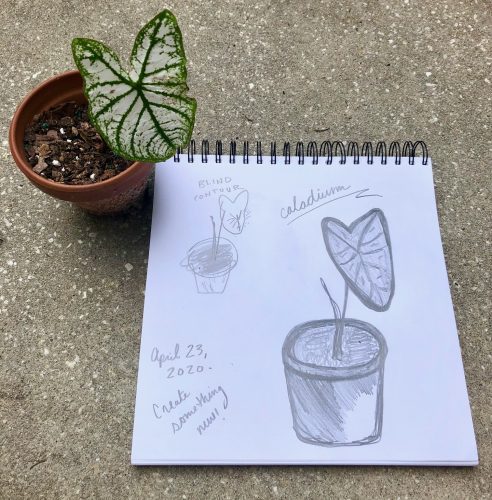
It’s been a while since I’ve done a blind contour so this was a challenge! It’s always so hard not to look at the drawing and then, not judge yourself! But, since I told you not to worry about drawing for perfection, I tried to the same in my own challenge. I guess that’s why we call this a “challenge” and not a “breeze.” Of course, on my first go of this, I picked a plant with so many branches that I decided to scale back and pick something a little more simple. I’ve been loving the pattern on this caladium bulb so it seemed like the right choice. Now, I’m sitting on my porch wishing I could see what you have drawn up!
Day 5: Write an ode to nature!
Think about a favorite place in nature. Spend 15 minutes writing a haiku, short story, or letter in honor of this place.
Often when I’m in a new natural place, I get emotional. These emotions come out in different ways. Riding on the back of a motorcycle through the jungles of Thailand after a rainstorm had me crying like a baby inside my helmet. On a solo road trip through the Rocky Mountains, I got angry. I said out loud to absolutely no one, “How could anything be so beautiful? Why did it take me so long to see these glorious peaks?!”
On the fifth and last day of this challenge, let’s write an ode to these beautiful natural places and try to channel the emotions felt when being there in person. Maybe write a poem, a story, or even a letter. It doesn’t have to be long or fancy, just try to be vulnerable and open up to these places of wonder. Finally, add this to your journal.
April 24, 2020:
The last day of the challenge and this was so wonderful. I don’t know about you readers, but I definitely plan to continue doing these activities, especially today’s writing challenge which gave me the chance to reflect on some lifechanging nature memories. I decided to write two haikus about the locations mentioned above. I also contributed to the Museum’s 6-words for the planet challenge.
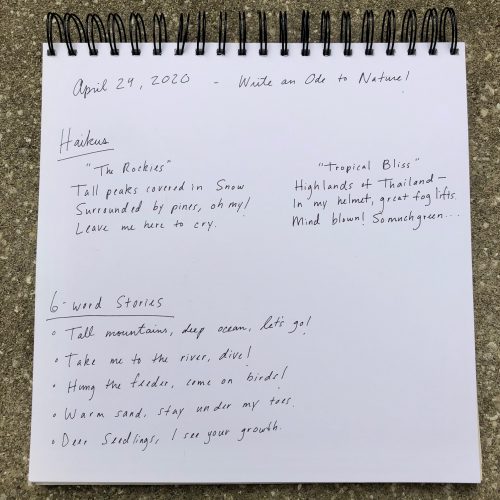
Haikus –
“The Rockies”
Tall peaks covered in snow.
Surrounded by pines, oh my!
Leave me here to cry.
“Tropical Bliss”
Highlands of Thailand –
In my helmet, great fog lifts.
Mind blown! So much green…
6-Word Stories –
- Tall mountains, deep ocean, let’s go!
- Take me to the river, dive!
- Bright sails on calm waters, shh….
- Hung the feeder, come on birds!
- Dear seedlings, I see your growth.
- Warm sand, stay under my toes.
This originally appeared in Wonder & Grow, a blog by Chelsea Collison, one of our former Museum educators.

